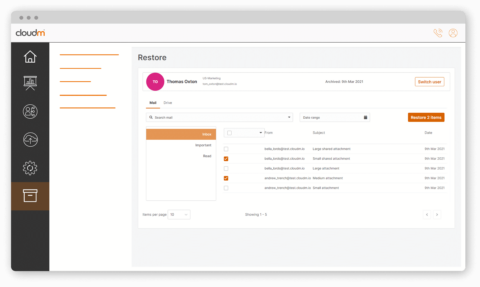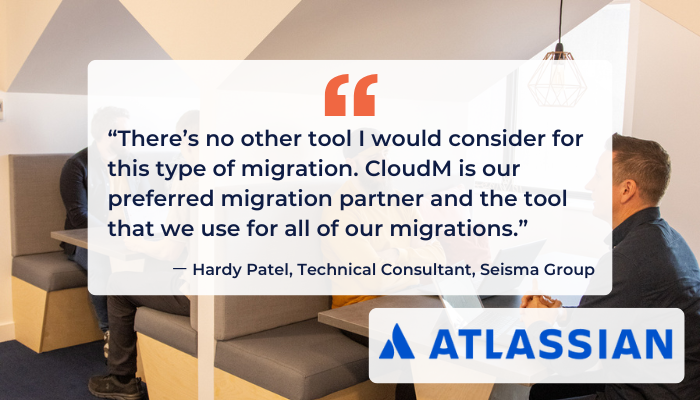7 common employee offboarding mistakes
Keep your domain secure and take the stress out of offboarding with smart automation
The gifts have been given, the laptop has been safely returned to IT, and the last few sips of those leaving drinks have been sunk. It may be a sad or stressful time when an employee leaves, but it’s also an unavoidable part of business, regardless of your size or success.
Now comes the important part; securing your domain, storing the leaver’s data properly, and claiming back licenses to avoid spiraling costs. But are you making this necessary process harder than it needs to be? Here are 7 common mistakes that are made when offboarding employees, and how you can avoid them with CloudM.
Mistake 1
Leaving offboarded users on a full license
You can’t just delete your leaver’s data. If you do, be prepared to be stung by a massive, potentially company crippling, fine for breaching data retention rules.
Some companies deal with this issue by leaving the offboarded user on a full license, and stopping their access. Whilst you may avoid the fine and secure the data, you will soon see license costs spiral.
It may not seem like a lot at an individual level, but let’s do the math. If every leaver is replaced by a new starter, then for each role you now have two live licenses; one for the leaver and one for the joiner. With the average attrition rate in the US now up to 25%, that means your license bill is doubling every four years!
CloudM gives you two options to free up the license without losing your data.
The first is to automatically store all the data in Cloud Storage using our industry-leading Archive feature.
Alternatively, for those of you on Google Workspace, you can automatically apply a Google Archived User (AU) license to the leaver during their offboarding, which is considerably cheaper than keeping a full license, allowing you to free up the existing license for their replacement.
Mistake 2
Moving all data to a single generic or archive account
Companies who are actively trying to avoid the license creep from Mistake 1 can sometimes fall into the trap of our second mistake; sending the data of every user to the same “Leavers” account.
It may seem like a good idea on the surface. One full license is a lot cheaper than hundreds or thousands of individual licenses. But what happens when you need to search and restore data from one individual?
These generic accounts for offboarded users become almost impossible to use, as there is no way to know what data belonged to each user. It also places you in a precarious position when it comes to data purging, as it’s difficult to tell when data was added.
Keeping data longer than you should can leave you susceptible to data retention punishments, so while you may avoid being fined for not keeping data at all, you’re now at risk of fines for keeping data for too long. These huge accounts may also hit size limits on contacts, labels, emails and storage, resulting in admin nightmares or a hefty bill.
Applying the “Archive” or “Apply Google AU license” steps into your automated offboarding workflow in CloudM is a simple way to keep your data segmented and easy to manage, without the headaches.
CloudM Archive in particular gives you a simple way of searching for and restoring any individual file or email in your Cloud Storage, and automatically purges data in accordance with a data retention policy.
You can have the peace of mind that you are staying compliant, safe in the knowledge you can also deal with Freedom of Information and Litigation requests in a few, quick clicks.

Mistake 3
Orphaning files and folders that were owned by the leaver
Nothing supercharges collaboration like the ability to share files and folders with your colleagues, but offboarding the owner of the file or folder can lead to the resource being orphaned and inaccessible to the other users it is shared with, requiring a domain administrator to intervene and reassign.
CloudM allows you to quickly and simply assign the Owner permission for the existing file or folder to a new user as part of the automated offboarding process, giving you one less support ticket to deal with.
Mistake 4
Not removing Recovery Methods
You’ve changed the user’s password to your domain – they are locked out of their applications, right? Unfortunately, the answer is no if the user has a password recovery method that utilizes a personal email address or mobile number!
The leaver can simply use this to change their password again and gain full access (until their full license is removed), increasing the threat of a malicious action taking place. CloudM allows you to add a step to your offboarding policies that removes the recovery method from the account, so you can be sure your data is secure.
Mistake 5
Applying the same policy to all users
It can be easy to think that one policy fits all, especially when depending on manual processes. But your Marketing Team aren’t the same as your Support Team, and offboarding a Manager may require a lot more tasks to be completed when compared to your Temp staff, for example.
This is why CloudM allows you to create policies for each Organizational Unit and Smart Team in your domain, giving you flexibility to tailor the process, without compromising on accuracy and standardization.
And, best of all, your IT team doesn’t have to remember each step for each team. It’s all done automatically.
Mistake 6
Not giving yourself time and/or safeguards to spot and correct an accidental offboarding
Have you ever sent an email to John Smith when you meant to send it to John Smyth?
Mistakes can happen, but offboarding the wrong person could leave your domain unsecured, lock out a key employee, and cause a headache for IT as they unpick the process.
With CloudM, you can choose to set your policy to require a manual confirmation before the process starts, allowing you to spot a case of mistaken identity (or a malicious action) before it’s too late.
You can also set custom delays on individual steps, allowing you to secure your domain quickly and simply by removing access before giving yourself a buffer before other stages commence. This helps you to potentially stop or reverse the process with minimal damage to your data.
Mistake 7
Not automating your offboarding process at all
The biggest faux pas when offboarding leavers is to completely rely on your IT teams to carry out manual tasks. Not because they aren’t capable, but because it is a waste of their precious time and skill, and an unnecessary cost to your business (not to mention that it does increase the odds of human error).
CloudM allows you to place all these menial tasks into simple automated policies, freeing up your IT teams to concentrate on improving your services, and not sweating the small stuff.
Offboarding made easy
Offboarding is just one of a range of CloudM features that take the hassle out of managing your domain, including Onboarding, Email Signature Management and SaaS license management.
We build automation and customization into the heart of every process to provide a cost-efficient, self-sufficient solution that turns IT Hell into IT Heaven.
Ready to deploy CloudM and make offboarding easy?









